Critical Evaluation of Evidence: HLSC122, Sem 2, 2017 Assessment 3
VerifiedAdded on 2019/10/31
|13
|3051
|356
Report
AI Summary
This report critically evaluates two research studies concerning the impact of cognitive enhancers on the academic performance of university students. The first study, by Hildt, Lieb, & Franke (2014), explores the context of psychostimulant use through qualitative interviews, examining motivations and subjective experiences. The second study, by Munro, Weyandt, Marraccini, & Oster (2017), investigates the relationship between non-medical prescription stimulant use (NMPSU), executive function, and academic outcomes using surveys and statistical analysis. The report analyzes the research methodologies, findings, strengths, and weaknesses of each study, including the barriers to applying evidence-based practices. It concludes that cognitive enhancers are ineffective in improving academic performance and highlights the need for counseling and education to reduce students' reliance on prescription drugs. The report also discusses how closely the research studies align with the PICO question elements. Both studies reveal the complexities of stimulant use and its impact on students' lives.
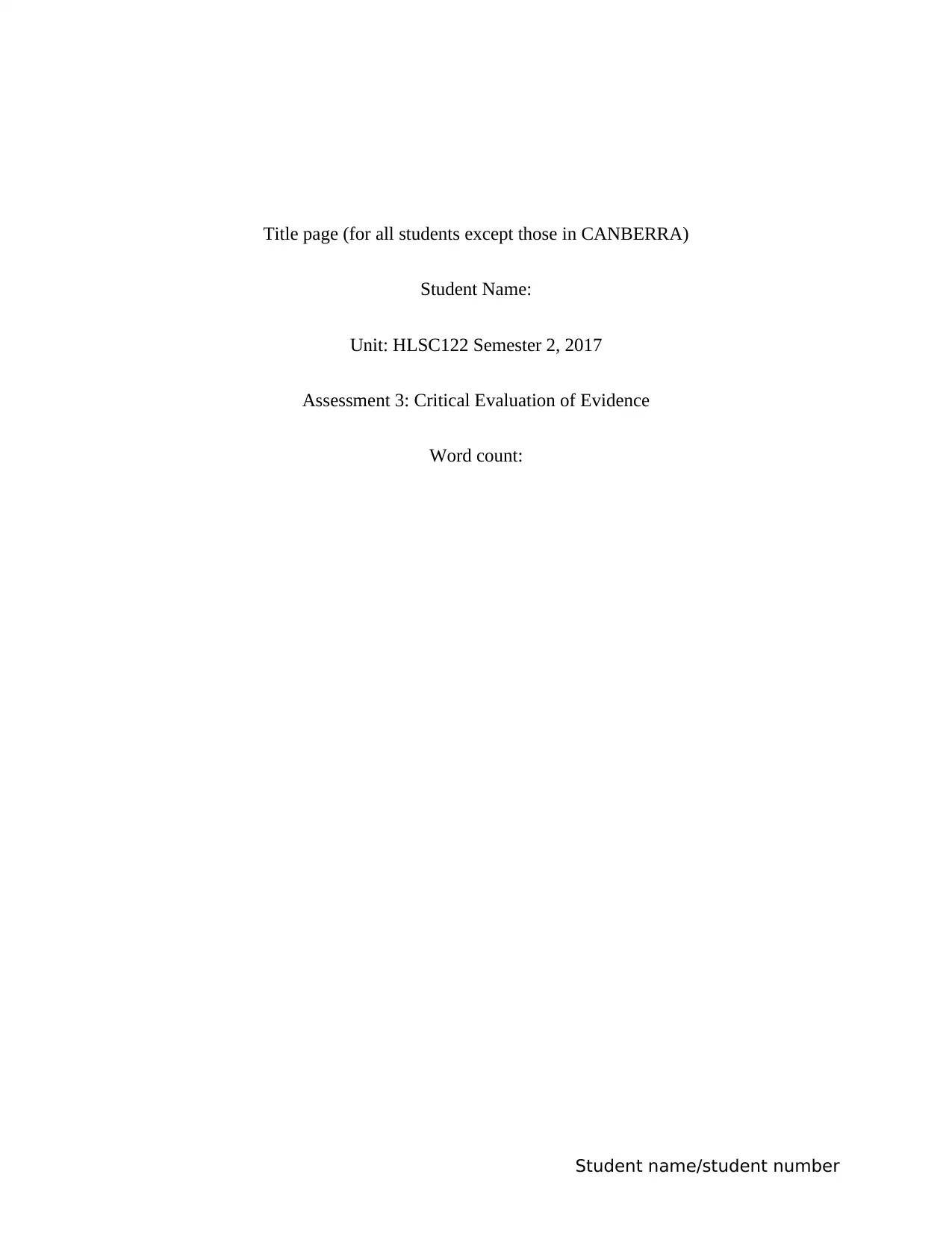
Title page (for all students except those in CANBERRA)
Student Name:
Unit: HLSC122 Semester 2, 2017
Assessment 3: Critical Evaluation of Evidence
Word count:
Student name/student number
Student Name:
Unit: HLSC122 Semester 2, 2017
Assessment 3: Critical Evaluation of Evidence
Word count:
Student name/student number
Paraphrase This Document
Need a fresh take? Get an instant paraphrase of this document with our AI Paraphraser
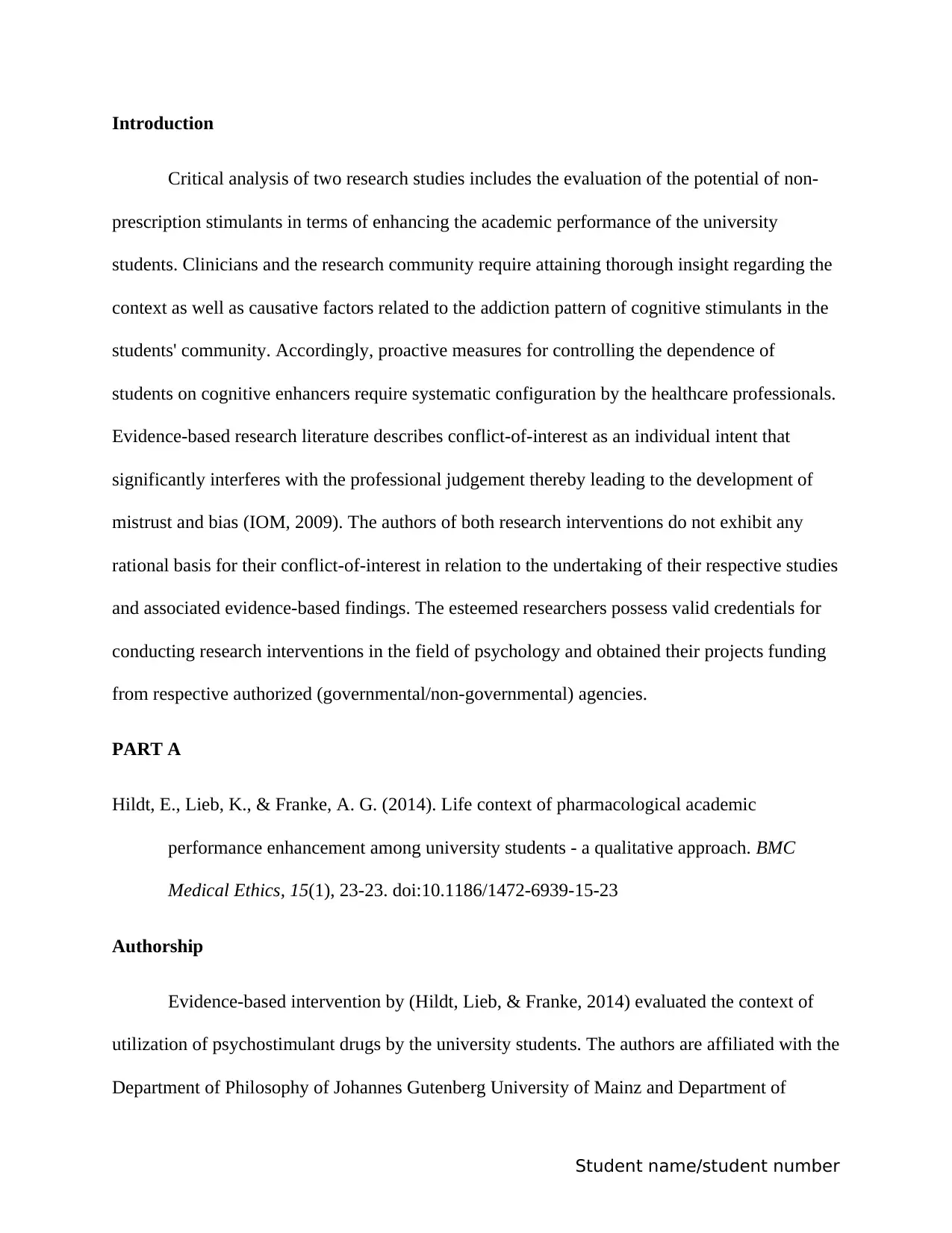
Introduction
Critical analysis of two research studies includes the evaluation of the potential of non-
prescription stimulants in terms of enhancing the academic performance of the university
students. Clinicians and the research community require attaining thorough insight regarding the
context as well as causative factors related to the addiction pattern of cognitive stimulants in the
students' community. Accordingly, proactive measures for controlling the dependence of
students on cognitive enhancers require systematic configuration by the healthcare professionals.
Evidence-based research literature describes conflict-of-interest as an individual intent that
significantly interferes with the professional judgement thereby leading to the development of
mistrust and bias (IOM, 2009). The authors of both research interventions do not exhibit any
rational basis for their conflict-of-interest in relation to the undertaking of their respective studies
and associated evidence-based findings. The esteemed researchers possess valid credentials for
conducting research interventions in the field of psychology and obtained their projects funding
from respective authorized (governmental/non-governmental) agencies.
PART A
Hildt, E., Lieb, K., & Franke, A. G. (2014). Life context of pharmacological academic
performance enhancement among university students - a qualitative approach. BMC
Medical Ethics, 15(1), 23-23. doi:10.1186/1472-6939-15-23
Authorship
Evidence-based intervention by (Hildt, Lieb, & Franke, 2014) evaluated the context of
utilization of psychostimulant drugs by the university students. The authors are affiliated with the
Department of Philosophy of Johannes Gutenberg University of Mainz and Department of
Student name/student number
Critical analysis of two research studies includes the evaluation of the potential of non-
prescription stimulants in terms of enhancing the academic performance of the university
students. Clinicians and the research community require attaining thorough insight regarding the
context as well as causative factors related to the addiction pattern of cognitive stimulants in the
students' community. Accordingly, proactive measures for controlling the dependence of
students on cognitive enhancers require systematic configuration by the healthcare professionals.
Evidence-based research literature describes conflict-of-interest as an individual intent that
significantly interferes with the professional judgement thereby leading to the development of
mistrust and bias (IOM, 2009). The authors of both research interventions do not exhibit any
rational basis for their conflict-of-interest in relation to the undertaking of their respective studies
and associated evidence-based findings. The esteemed researchers possess valid credentials for
conducting research interventions in the field of psychology and obtained their projects funding
from respective authorized (governmental/non-governmental) agencies.
PART A
Hildt, E., Lieb, K., & Franke, A. G. (2014). Life context of pharmacological academic
performance enhancement among university students - a qualitative approach. BMC
Medical Ethics, 15(1), 23-23. doi:10.1186/1472-6939-15-23
Authorship
Evidence-based intervention by (Hildt, Lieb, & Franke, 2014) evaluated the context of
utilization of psychostimulant drugs by the university students. The authors are affiliated with the
Department of Philosophy of Johannes Gutenberg University of Mainz and Department of
Student name/student number

Psychiatry and Psychotherapy of the University Medical Centre. The academic profile of the
authors makes them eligible for conducting research studies on psychology and human
behaviour.
Research Aims
The research study by (Hildt, Lieb, & Franke, 2014) evaluated the causative factors
attributing to the utilization of psychostimulant drugs by university students for their academic
enhancement. Research intervention not only attempted to evaluate the outcomes of these
pharmacological interventions on the academic performance of the users, but also explored their
subjective experiences and motivational factors leading to the pattern of drug dependence and
associated adversities.
Population University students with overall normal
health pattern
Intervention Psychostimulants and prescription drugs
Comparison University students with normal executive
function
Outcomes Students’ experiences, addiction pattern,
causative factors and cognitive changes
Evidence-based research literature affirms the influence of psychotropic drugs on the
cognitive enhancement of adolescents and children affected with executive function disorders
(Hosenbocus&Chahal, 2012). Research intervention by (Ryan, et al., 2013) evidentially
Student name/student number
authors makes them eligible for conducting research studies on psychology and human
behaviour.
Research Aims
The research study by (Hildt, Lieb, & Franke, 2014) evaluated the causative factors
attributing to the utilization of psychostimulant drugs by university students for their academic
enhancement. Research intervention not only attempted to evaluate the outcomes of these
pharmacological interventions on the academic performance of the users, but also explored their
subjective experiences and motivational factors leading to the pattern of drug dependence and
associated adversities.
Population University students with overall normal
health pattern
Intervention Psychostimulants and prescription drugs
Comparison University students with normal executive
function
Outcomes Students’ experiences, addiction pattern,
causative factors and cognitive changes
Evidence-based research literature affirms the influence of psychotropic drugs on the
cognitive enhancement of adolescents and children affected with executive function disorders
(Hosenbocus&Chahal, 2012). Research intervention by (Ryan, et al., 2013) evidentially
Student name/student number
⊘ This is a preview!⊘
Do you want full access?
Subscribe today to unlock all pages.

Trusted by 1+ million students worldwide
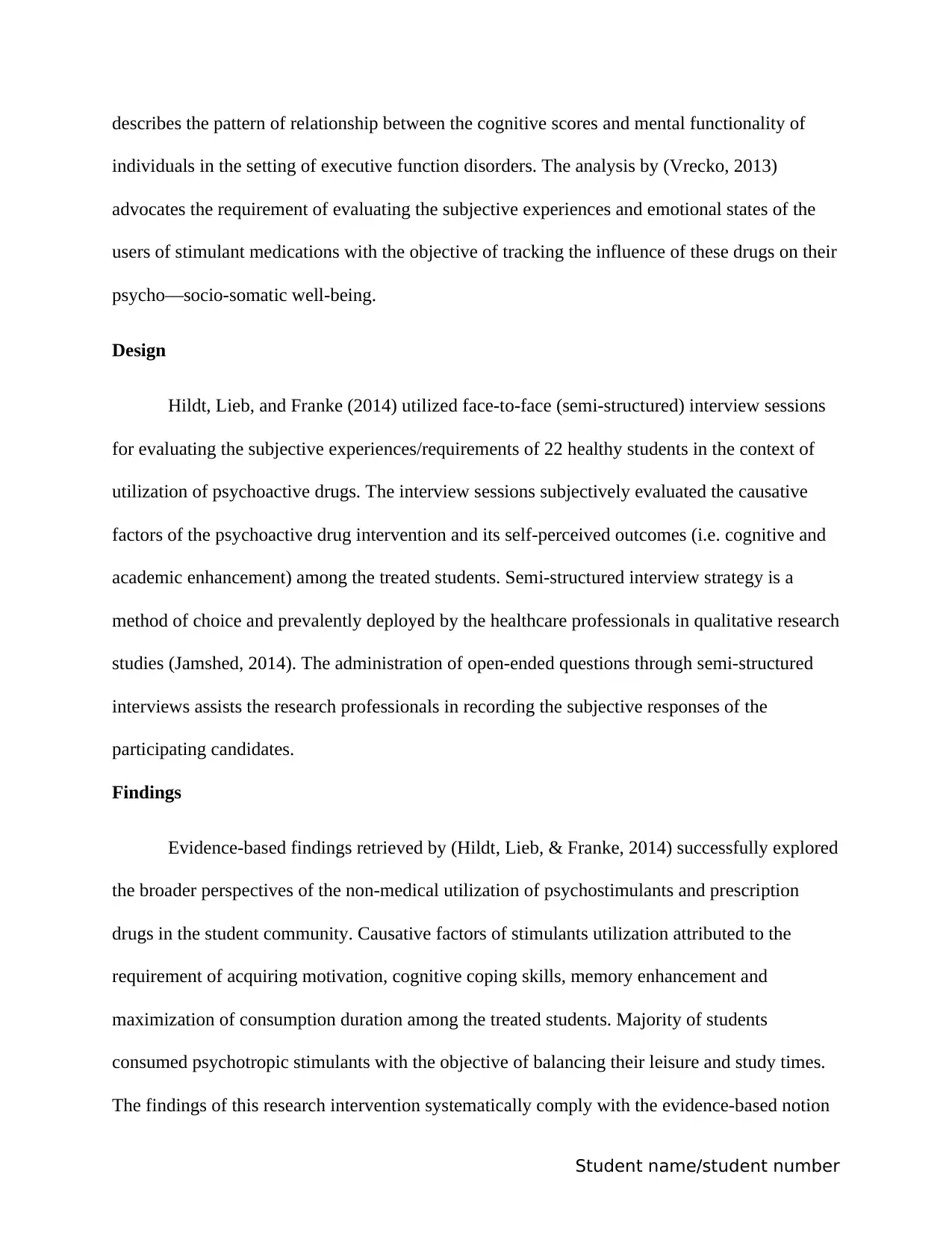
describes the pattern of relationship between the cognitive scores and mental functionality of
individuals in the setting of executive function disorders. The analysis by (Vrecko, 2013)
advocates the requirement of evaluating the subjective experiences and emotional states of the
users of stimulant medications with the objective of tracking the influence of these drugs on their
psycho—socio-somatic well-being.
Design
Hildt, Lieb, and Franke (2014) utilized face-to-face (semi-structured) interview sessions
for evaluating the subjective experiences/requirements of 22 healthy students in the context of
utilization of psychoactive drugs. The interview sessions subjectively evaluated the causative
factors of the psychoactive drug intervention and its self-perceived outcomes (i.e. cognitive and
academic enhancement) among the treated students. Semi-structured interview strategy is a
method of choice and prevalently deployed by the healthcare professionals in qualitative research
studies (Jamshed, 2014). The administration of open-ended questions through semi-structured
interviews assists the research professionals in recording the subjective responses of the
participating candidates.
Findings
Evidence-based findings retrieved by (Hildt, Lieb, & Franke, 2014) successfully explored
the broader perspectives of the non-medical utilization of psychostimulants and prescription
drugs in the student community. Causative factors of stimulants utilization attributed to the
requirement of acquiring motivation, cognitive coping skills, memory enhancement and
maximization of consumption duration among the treated students. Majority of students
consumed psychotropic stimulants with the objective of balancing their leisure and study times.
The findings of this research intervention systematically comply with the evidence-based notion
Student name/student number
individuals in the setting of executive function disorders. The analysis by (Vrecko, 2013)
advocates the requirement of evaluating the subjective experiences and emotional states of the
users of stimulant medications with the objective of tracking the influence of these drugs on their
psycho—socio-somatic well-being.
Design
Hildt, Lieb, and Franke (2014) utilized face-to-face (semi-structured) interview sessions
for evaluating the subjective experiences/requirements of 22 healthy students in the context of
utilization of psychoactive drugs. The interview sessions subjectively evaluated the causative
factors of the psychoactive drug intervention and its self-perceived outcomes (i.e. cognitive and
academic enhancement) among the treated students. Semi-structured interview strategy is a
method of choice and prevalently deployed by the healthcare professionals in qualitative research
studies (Jamshed, 2014). The administration of open-ended questions through semi-structured
interviews assists the research professionals in recording the subjective responses of the
participating candidates.
Findings
Evidence-based findings retrieved by (Hildt, Lieb, & Franke, 2014) successfully explored
the broader perspectives of the non-medical utilization of psychostimulants and prescription
drugs in the student community. Causative factors of stimulants utilization attributed to the
requirement of acquiring motivation, cognitive coping skills, memory enhancement and
maximization of consumption duration among the treated students. Majority of students
consumed psychotropic stimulants with the objective of balancing their leisure and study times.
The findings of this research intervention systematically comply with the evidence-based notion
Student name/student number
Paraphrase This Document
Need a fresh take? Get an instant paraphrase of this document with our AI Paraphraser
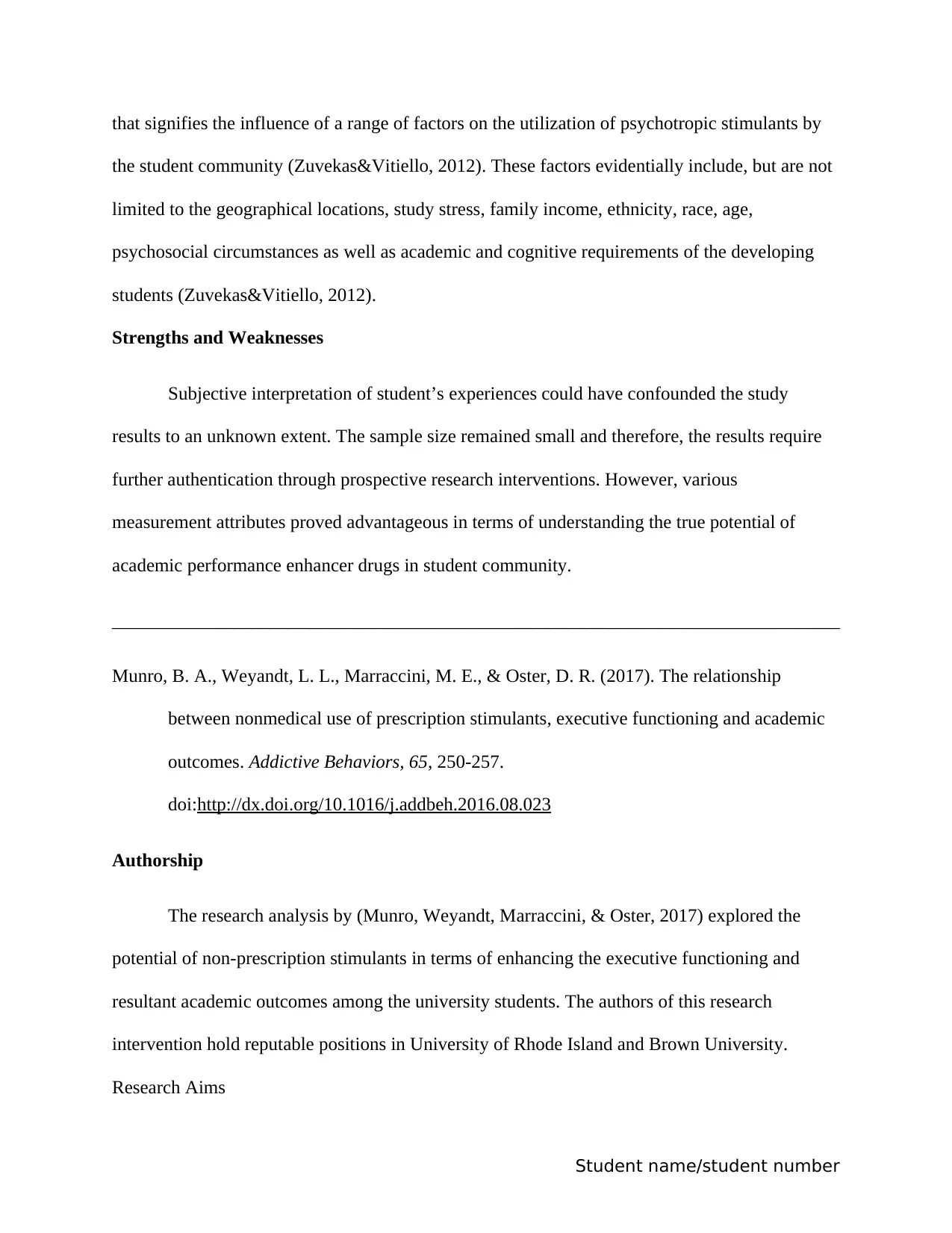
that signifies the influence of a range of factors on the utilization of psychotropic stimulants by
the student community (Zuvekas&Vitiello, 2012). These factors evidentially include, but are not
limited to the geographical locations, study stress, family income, ethnicity, race, age,
psychosocial circumstances as well as academic and cognitive requirements of the developing
students (Zuvekas&Vitiello, 2012).
Strengths and Weaknesses
Subjective interpretation of student’s experiences could have confounded the study
results to an unknown extent. The sample size remained small and therefore, the results require
further authentication through prospective research interventions. However, various
measurement attributes proved advantageous in terms of understanding the true potential of
academic performance enhancer drugs in student community.
______________________________________________________________________________
Munro, B. A., Weyandt, L. L., Marraccini, M. E., & Oster, D. R. (2017). The relationship
between nonmedical use of prescription stimulants, executive functioning and academic
outcomes. Addictive Behaviors, 65, 250-257.
doi:http://dx.doi.org/10.1016/j.addbeh.2016.08.023
Authorship
The research analysis by (Munro, Weyandt, Marraccini, & Oster, 2017) explored the
potential of non-prescription stimulants in terms of enhancing the executive functioning and
resultant academic outcomes among the university students. The authors of this research
intervention hold reputable positions in University of Rhode Island and Brown University.
Research Aims
Student name/student number
the student community (Zuvekas&Vitiello, 2012). These factors evidentially include, but are not
limited to the geographical locations, study stress, family income, ethnicity, race, age,
psychosocial circumstances as well as academic and cognitive requirements of the developing
students (Zuvekas&Vitiello, 2012).
Strengths and Weaknesses
Subjective interpretation of student’s experiences could have confounded the study
results to an unknown extent. The sample size remained small and therefore, the results require
further authentication through prospective research interventions. However, various
measurement attributes proved advantageous in terms of understanding the true potential of
academic performance enhancer drugs in student community.
______________________________________________________________________________
Munro, B. A., Weyandt, L. L., Marraccini, M. E., & Oster, D. R. (2017). The relationship
between nonmedical use of prescription stimulants, executive functioning and academic
outcomes. Addictive Behaviors, 65, 250-257.
doi:http://dx.doi.org/10.1016/j.addbeh.2016.08.023
Authorship
The research analysis by (Munro, Weyandt, Marraccini, & Oster, 2017) explored the
potential of non-prescription stimulants in terms of enhancing the executive functioning and
resultant academic outcomes among the university students. The authors of this research
intervention hold reputable positions in University of Rhode Island and Brown University.
Research Aims
Student name/student number

The research intervention by (Munro, Weyandt, Marraccini, & Oster, 2017) attempted to
evaluate the influence of NMUPS (non-medical use of prescription stimulants) on the executive
function (and resultant academic performance) of the university students with normal cognition,
in comparison to the individuals with reduced cognitive capacity.
Population University students with reduced executive
function
Intervention NMUPS
Comparison University students with normal executive
function
Outcomes Alteration in the executive function and
cognitive abilities of the participating subjects
Evidence-based research literature documents the prevalent utilization of prescription
stimulants among undergraduate students for their cognitive enhancement (Herman, et al., 2011).
However, this non-medical utilization leads to the development of drugs addiction behaviour in
the students’ community. The research analysis by advocates the capacity of prescription
stimulants in terms of enhancing the executive function of individuals irrespective of their
cognitive statuses. Prescription drugs administered for treating ADHD elevate the executive
potential of mentally fit individuals, as revealed by the study findings (Smith & Farah, 2011).
Arria and DuPont (2010) describe the utilization of non-prescription stimulants among the
college students in terms of a complex psychosocial behaviour requiring analysis in a broader
context. Limited research interventions comparatively analysed the NMUPS behaviour among
Student name/student number
evaluate the influence of NMUPS (non-medical use of prescription stimulants) on the executive
function (and resultant academic performance) of the university students with normal cognition,
in comparison to the individuals with reduced cognitive capacity.
Population University students with reduced executive
function
Intervention NMUPS
Comparison University students with normal executive
function
Outcomes Alteration in the executive function and
cognitive abilities of the participating subjects
Evidence-based research literature documents the prevalent utilization of prescription
stimulants among undergraduate students for their cognitive enhancement (Herman, et al., 2011).
However, this non-medical utilization leads to the development of drugs addiction behaviour in
the students’ community. The research analysis by advocates the capacity of prescription
stimulants in terms of enhancing the executive function of individuals irrespective of their
cognitive statuses. Prescription drugs administered for treating ADHD elevate the executive
potential of mentally fit individuals, as revealed by the study findings (Smith & Farah, 2011).
Arria and DuPont (2010) describe the utilization of non-prescription stimulants among the
college students in terms of a complex psychosocial behaviour requiring analysis in a broader
context. Limited research interventions comparatively analysed the NMUPS behaviour among
Student name/student number
⊘ This is a preview!⊘
Do you want full access?
Subscribe today to unlock all pages.

Trusted by 1+ million students worldwide
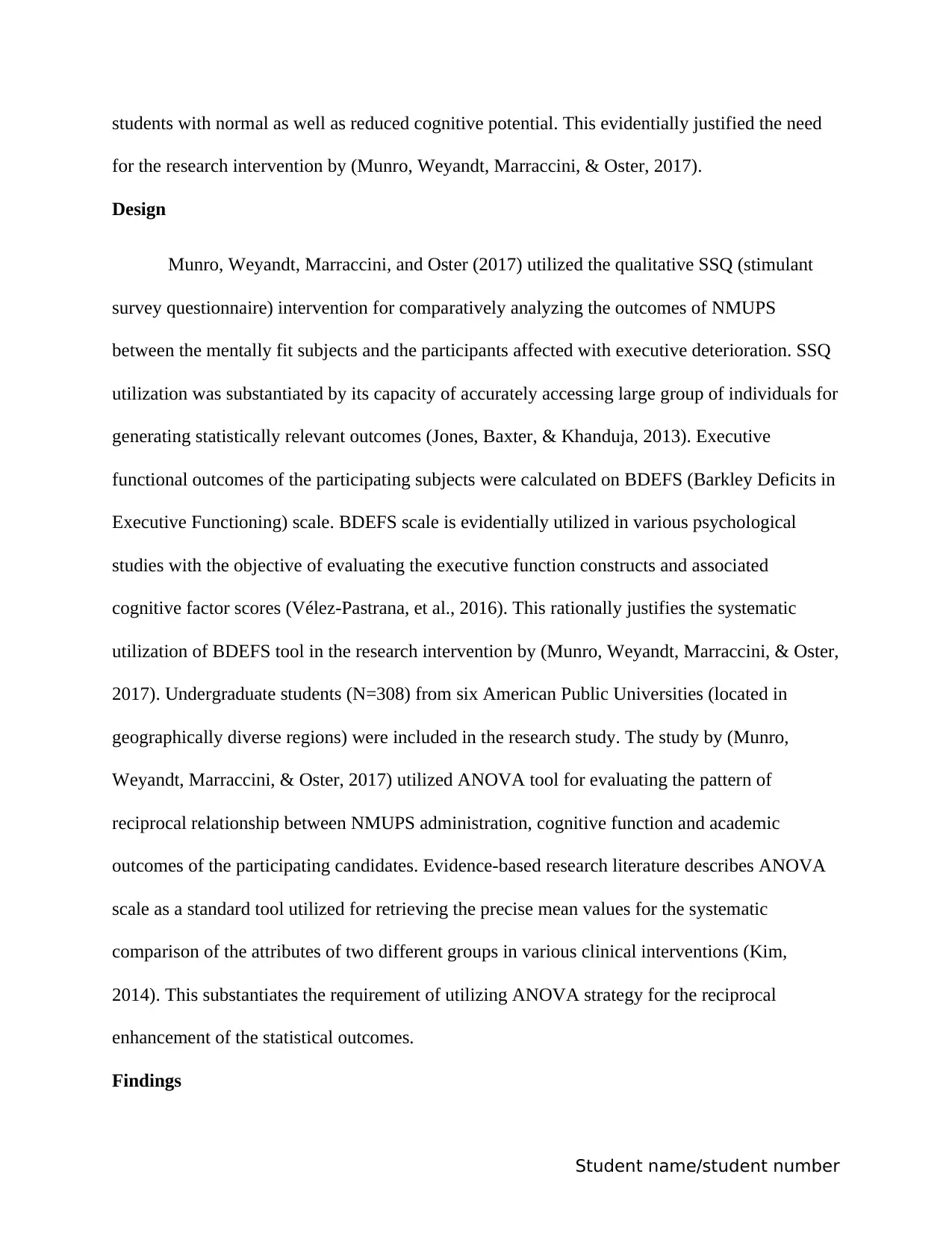
students with normal as well as reduced cognitive potential. This evidentially justified the need
for the research intervention by (Munro, Weyandt, Marraccini, & Oster, 2017).
Design
Munro, Weyandt, Marraccini, and Oster (2017) utilized the qualitative SSQ (stimulant
survey questionnaire) intervention for comparatively analyzing the outcomes of NMUPS
between the mentally fit subjects and the participants affected with executive deterioration. SSQ
utilization was substantiated by its capacity of accurately accessing large group of individuals for
generating statistically relevant outcomes (Jones, Baxter, & Khanduja, 2013). Executive
functional outcomes of the participating subjects were calculated on BDEFS (Barkley Deficits in
Executive Functioning) scale. BDEFS scale is evidentially utilized in various psychological
studies with the objective of evaluating the executive function constructs and associated
cognitive factor scores (Vélez-Pastrana, et al., 2016). This rationally justifies the systematic
utilization of BDEFS tool in the research intervention by (Munro, Weyandt, Marraccini, & Oster,
2017). Undergraduate students (N=308) from six American Public Universities (located in
geographically diverse regions) were included in the research study. The study by (Munro,
Weyandt, Marraccini, & Oster, 2017) utilized ANOVA tool for evaluating the pattern of
reciprocal relationship between NMUPS administration, cognitive function and academic
outcomes of the participating candidates. Evidence-based research literature describes ANOVA
scale as a standard tool utilized for retrieving the precise mean values for the systematic
comparison of the attributes of two different groups in various clinical interventions (Kim,
2014). This substantiates the requirement of utilizing ANOVA strategy for the reciprocal
enhancement of the statistical outcomes.
Findings
Student name/student number
for the research intervention by (Munro, Weyandt, Marraccini, & Oster, 2017).
Design
Munro, Weyandt, Marraccini, and Oster (2017) utilized the qualitative SSQ (stimulant
survey questionnaire) intervention for comparatively analyzing the outcomes of NMUPS
between the mentally fit subjects and the participants affected with executive deterioration. SSQ
utilization was substantiated by its capacity of accurately accessing large group of individuals for
generating statistically relevant outcomes (Jones, Baxter, & Khanduja, 2013). Executive
functional outcomes of the participating subjects were calculated on BDEFS (Barkley Deficits in
Executive Functioning) scale. BDEFS scale is evidentially utilized in various psychological
studies with the objective of evaluating the executive function constructs and associated
cognitive factor scores (Vélez-Pastrana, et al., 2016). This rationally justifies the systematic
utilization of BDEFS tool in the research intervention by (Munro, Weyandt, Marraccini, & Oster,
2017). Undergraduate students (N=308) from six American Public Universities (located in
geographically diverse regions) were included in the research study. The study by (Munro,
Weyandt, Marraccini, & Oster, 2017) utilized ANOVA tool for evaluating the pattern of
reciprocal relationship between NMUPS administration, cognitive function and academic
outcomes of the participating candidates. Evidence-based research literature describes ANOVA
scale as a standard tool utilized for retrieving the precise mean values for the systematic
comparison of the attributes of two different groups in various clinical interventions (Kim,
2014). This substantiates the requirement of utilizing ANOVA strategy for the reciprocal
enhancement of the statistical outcomes.
Findings
Student name/student number
Paraphrase This Document
Need a fresh take? Get an instant paraphrase of this document with our AI Paraphraser

The findings by (Munro, Weyandt, Marraccini, & Oster, 2017) rationally revealed the
ineffectiveness of NMUPS in terms of enhancing the cognitive and academic level of the
participants affected with sustained executive function deficits. The study findings indicated the
academic enhancement requirement as the preliminary cause of the elevated prevalence of
NMUPS in the student community. This study results comply to the evidence-based finding that
rationally confirms the elevated predisposition of university/college students towards acquiring
the pattern of NMUPS across the community environment (Arria, et al., 2017).
Strengths and Weaknesses
The disproportionate sample size deployed for undertaking the research study might
challenge the authenticity of the findings on a wider scale. The participants did not entirely
represent the student community affected by the non-medical consumption of prescription
enhancers. However, the study assessed the pattern of self-reported utilization of cognitive
stimulants through twenty different parameters extended by stimulant survey questionnaire.
PART B
Discuss the barriers for the application of evidence in practice
The greatest barrier to the utilization of evidence in clinical practice includes the time
factor. The absence of sufficient timeframe for evaluating the study outcomes evidentially
constraints its systematic administration by the research professionals (Bahadori, Raadabadi,
Ravangard, &Mahaki, 2016). The absence of time further restrains the development of new
thoughts that could substantially improve the pattern of clinical interventions and associated
healthcare outcomes. Another barrier to the application of evidence in healthcare practice
includes the inappropriate information technology (IT) and statistical skills of researchers,
physicians and nurse professionals (Majid, et al., 2011). The inaccessibility (of the clinicians) to
Student name/student number
ineffectiveness of NMUPS in terms of enhancing the cognitive and academic level of the
participants affected with sustained executive function deficits. The study findings indicated the
academic enhancement requirement as the preliminary cause of the elevated prevalence of
NMUPS in the student community. This study results comply to the evidence-based finding that
rationally confirms the elevated predisposition of university/college students towards acquiring
the pattern of NMUPS across the community environment (Arria, et al., 2017).
Strengths and Weaknesses
The disproportionate sample size deployed for undertaking the research study might
challenge the authenticity of the findings on a wider scale. The participants did not entirely
represent the student community affected by the non-medical consumption of prescription
enhancers. However, the study assessed the pattern of self-reported utilization of cognitive
stimulants through twenty different parameters extended by stimulant survey questionnaire.
PART B
Discuss the barriers for the application of evidence in practice
The greatest barrier to the utilization of evidence in clinical practice includes the time
factor. The absence of sufficient timeframe for evaluating the study outcomes evidentially
constraints its systematic administration by the research professionals (Bahadori, Raadabadi,
Ravangard, &Mahaki, 2016). The absence of time further restrains the development of new
thoughts that could substantially improve the pattern of clinical interventions and associated
healthcare outcomes. Another barrier to the application of evidence in healthcare practice
includes the inappropriate information technology (IT) and statistical skills of researchers,
physicians and nurse professionals (Majid, et al., 2011). The inaccessibility (of the clinicians) to
Student name/student number
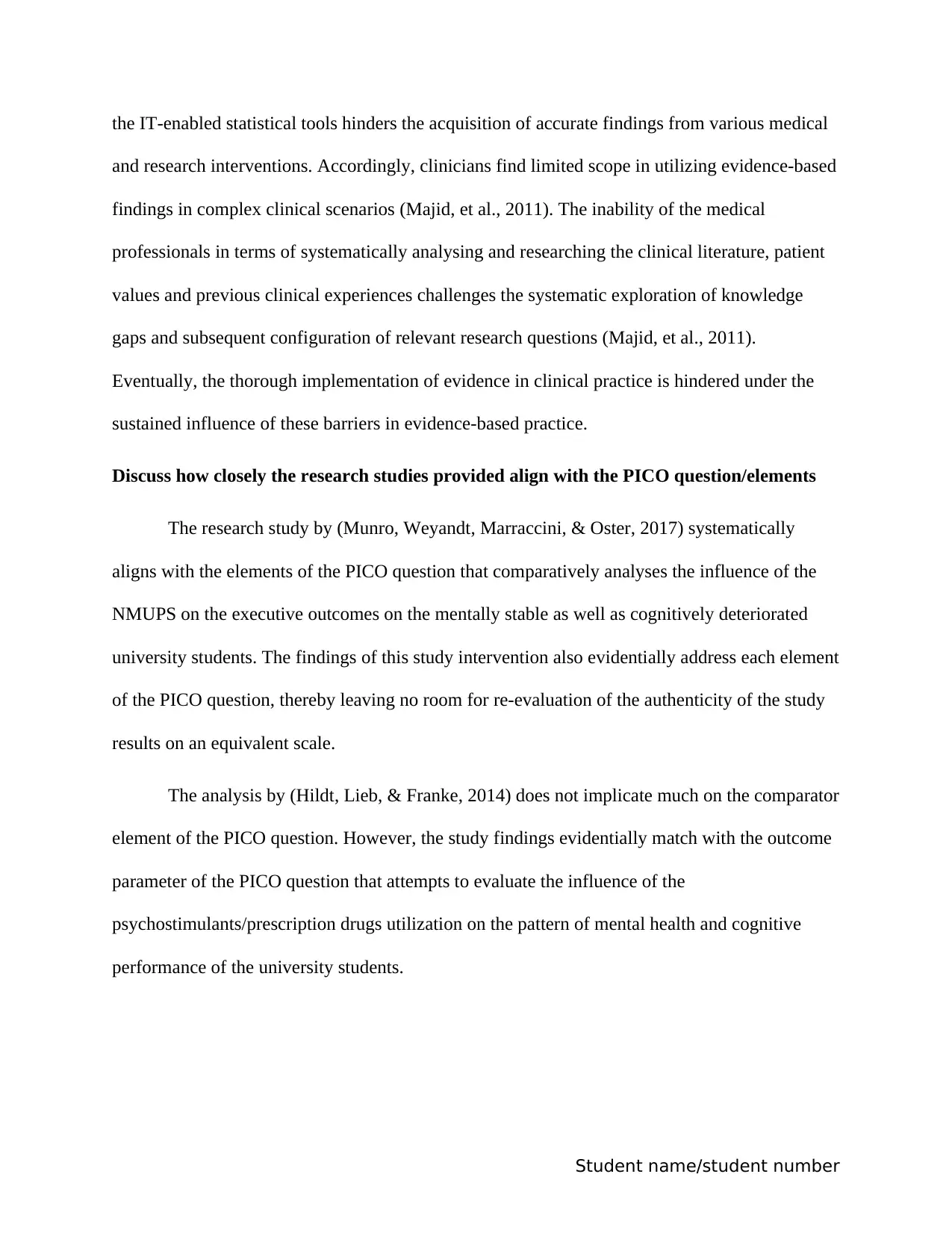
the IT-enabled statistical tools hinders the acquisition of accurate findings from various medical
and research interventions. Accordingly, clinicians find limited scope in utilizing evidence-based
findings in complex clinical scenarios (Majid, et al., 2011). The inability of the medical
professionals in terms of systematically analysing and researching the clinical literature, patient
values and previous clinical experiences challenges the systematic exploration of knowledge
gaps and subsequent configuration of relevant research questions (Majid, et al., 2011).
Eventually, the thorough implementation of evidence in clinical practice is hindered under the
sustained influence of these barriers in evidence-based practice.
Discuss how closely the research studies provided align with the PICO question/elements
The research study by (Munro, Weyandt, Marraccini, & Oster, 2017) systematically
aligns with the elements of the PICO question that comparatively analyses the influence of the
NMUPS on the executive outcomes on the mentally stable as well as cognitively deteriorated
university students. The findings of this study intervention also evidentially address each element
of the PICO question, thereby leaving no room for re-evaluation of the authenticity of the study
results on an equivalent scale.
The analysis by (Hildt, Lieb, & Franke, 2014) does not implicate much on the comparator
element of the PICO question. However, the study findings evidentially match with the outcome
parameter of the PICO question that attempts to evaluate the influence of the
psychostimulants/prescription drugs utilization on the pattern of mental health and cognitive
performance of the university students.
Student name/student number
and research interventions. Accordingly, clinicians find limited scope in utilizing evidence-based
findings in complex clinical scenarios (Majid, et al., 2011). The inability of the medical
professionals in terms of systematically analysing and researching the clinical literature, patient
values and previous clinical experiences challenges the systematic exploration of knowledge
gaps and subsequent configuration of relevant research questions (Majid, et al., 2011).
Eventually, the thorough implementation of evidence in clinical practice is hindered under the
sustained influence of these barriers in evidence-based practice.
Discuss how closely the research studies provided align with the PICO question/elements
The research study by (Munro, Weyandt, Marraccini, & Oster, 2017) systematically
aligns with the elements of the PICO question that comparatively analyses the influence of the
NMUPS on the executive outcomes on the mentally stable as well as cognitively deteriorated
university students. The findings of this study intervention also evidentially address each element
of the PICO question, thereby leaving no room for re-evaluation of the authenticity of the study
results on an equivalent scale.
The analysis by (Hildt, Lieb, & Franke, 2014) does not implicate much on the comparator
element of the PICO question. However, the study findings evidentially match with the outcome
parameter of the PICO question that attempts to evaluate the influence of the
psychostimulants/prescription drugs utilization on the pattern of mental health and cognitive
performance of the university students.
Student name/student number
⊘ This is a preview!⊘
Do you want full access?
Subscribe today to unlock all pages.

Trusted by 1+ million students worldwide
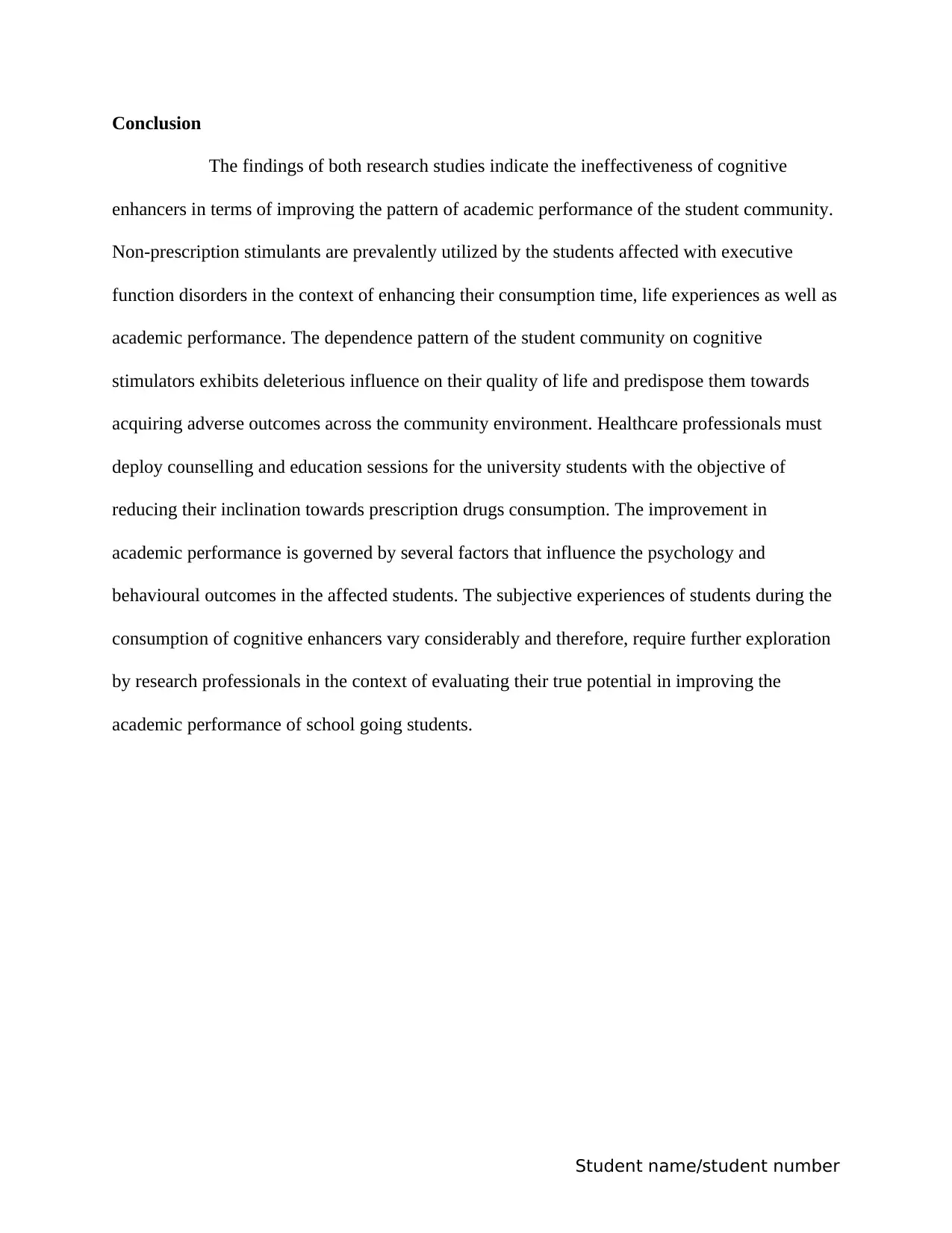
Conclusion
The findings of both research studies indicate the ineffectiveness of cognitive
enhancers in terms of improving the pattern of academic performance of the student community.
Non-prescription stimulants are prevalently utilized by the students affected with executive
function disorders in the context of enhancing their consumption time, life experiences as well as
academic performance. The dependence pattern of the student community on cognitive
stimulators exhibits deleterious influence on their quality of life and predispose them towards
acquiring adverse outcomes across the community environment. Healthcare professionals must
deploy counselling and education sessions for the university students with the objective of
reducing their inclination towards prescription drugs consumption. The improvement in
academic performance is governed by several factors that influence the psychology and
behavioural outcomes in the affected students. The subjective experiences of students during the
consumption of cognitive enhancers vary considerably and therefore, require further exploration
by research professionals in the context of evaluating their true potential in improving the
academic performance of school going students.
Student name/student number
The findings of both research studies indicate the ineffectiveness of cognitive
enhancers in terms of improving the pattern of academic performance of the student community.
Non-prescription stimulants are prevalently utilized by the students affected with executive
function disorders in the context of enhancing their consumption time, life experiences as well as
academic performance. The dependence pattern of the student community on cognitive
stimulators exhibits deleterious influence on their quality of life and predispose them towards
acquiring adverse outcomes across the community environment. Healthcare professionals must
deploy counselling and education sessions for the university students with the objective of
reducing their inclination towards prescription drugs consumption. The improvement in
academic performance is governed by several factors that influence the psychology and
behavioural outcomes in the affected students. The subjective experiences of students during the
consumption of cognitive enhancers vary considerably and therefore, require further exploration
by research professionals in the context of evaluating their true potential in improving the
academic performance of school going students.
Student name/student number
Paraphrase This Document
Need a fresh take? Get an instant paraphrase of this document with our AI Paraphraser
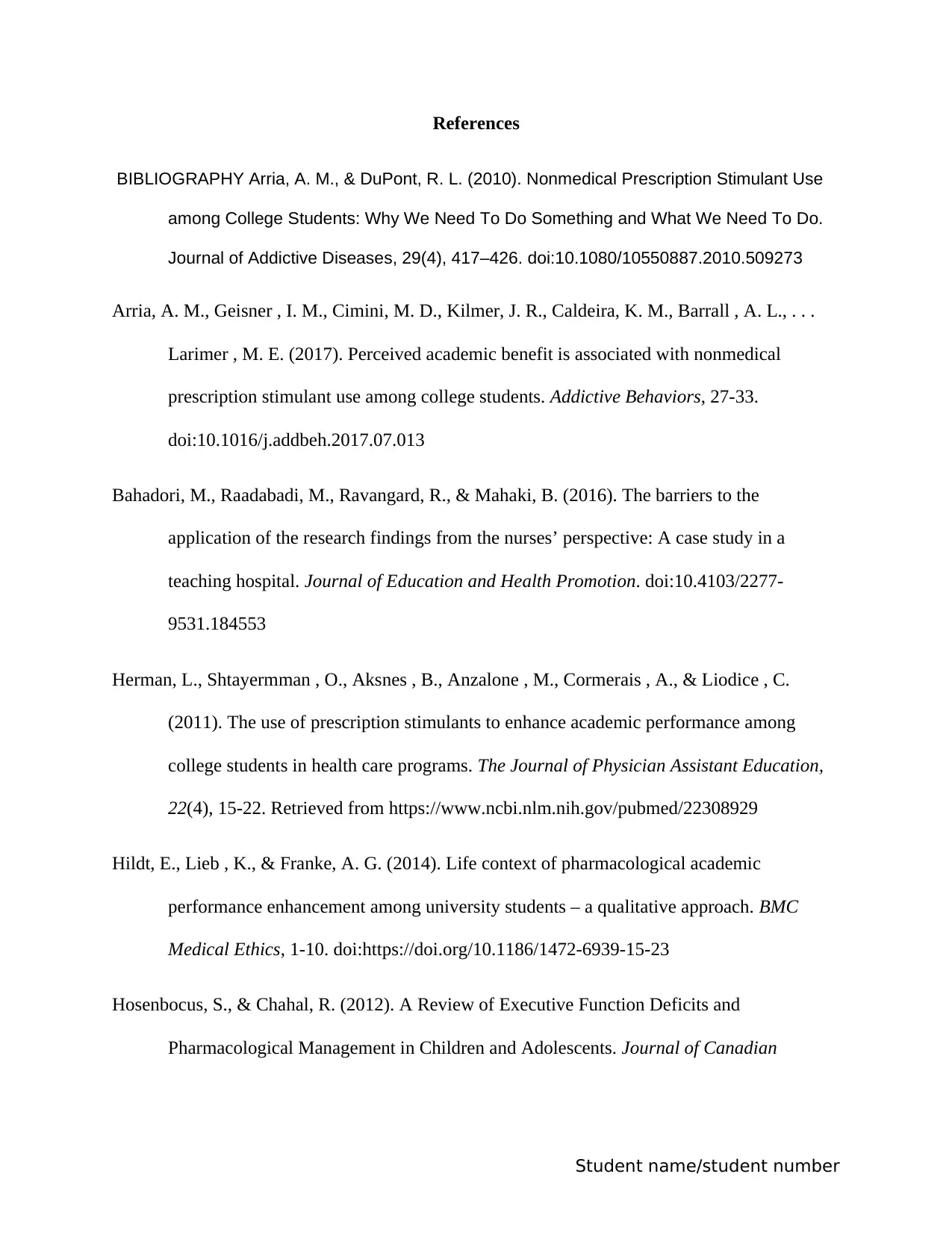
References
BIBLIOGRAPHY Arria, A. M., & DuPont, R. L. (2010). Nonmedical Prescription Stimulant Use
among College Students: Why We Need To Do Something and What We Need To Do.
Journal of Addictive Diseases, 29(4), 417–426. doi:10.1080/10550887.2010.509273
Arria, A. M., Geisner , I. M., Cimini, M. D., Kilmer, J. R., Caldeira, K. M., Barrall , A. L., . . .
Larimer , M. E. (2017). Perceived academic benefit is associated with nonmedical
prescription stimulant use among college students. Addictive Behaviors, 27-33.
doi:10.1016/j.addbeh.2017.07.013
Bahadori, M., Raadabadi, M., Ravangard, R., & Mahaki, B. (2016). The barriers to the
application of the research findings from the nurses’ perspective: A case study in a
teaching hospital. Journal of Education and Health Promotion. doi:10.4103/2277-
9531.184553
Herman, L., Shtayermman , O., Aksnes , B., Anzalone , M., Cormerais , A., & Liodice , C.
(2011). The use of prescription stimulants to enhance academic performance among
college students in health care programs. The Journal of Physician Assistant Education,
22(4), 15-22. Retrieved from https://www.ncbi.nlm.nih.gov/pubmed/22308929
Hildt, E., Lieb , K., & Franke, A. G. (2014). Life context of pharmacological academic
performance enhancement among university students – a qualitative approach. BMC
Medical Ethics, 1-10. doi:https://doi.org/10.1186/1472-6939-15-23
Hosenbocus, S., & Chahal, R. (2012). A Review of Executive Function Deficits and
Pharmacological Management in Children and Adolescents. Journal of Canadian
Student name/student number
BIBLIOGRAPHY Arria, A. M., & DuPont, R. L. (2010). Nonmedical Prescription Stimulant Use
among College Students: Why We Need To Do Something and What We Need To Do.
Journal of Addictive Diseases, 29(4), 417–426. doi:10.1080/10550887.2010.509273
Arria, A. M., Geisner , I. M., Cimini, M. D., Kilmer, J. R., Caldeira, K. M., Barrall , A. L., . . .
Larimer , M. E. (2017). Perceived academic benefit is associated with nonmedical
prescription stimulant use among college students. Addictive Behaviors, 27-33.
doi:10.1016/j.addbeh.2017.07.013
Bahadori, M., Raadabadi, M., Ravangard, R., & Mahaki, B. (2016). The barriers to the
application of the research findings from the nurses’ perspective: A case study in a
teaching hospital. Journal of Education and Health Promotion. doi:10.4103/2277-
9531.184553
Herman, L., Shtayermman , O., Aksnes , B., Anzalone , M., Cormerais , A., & Liodice , C.
(2011). The use of prescription stimulants to enhance academic performance among
college students in health care programs. The Journal of Physician Assistant Education,
22(4), 15-22. Retrieved from https://www.ncbi.nlm.nih.gov/pubmed/22308929
Hildt, E., Lieb , K., & Franke, A. G. (2014). Life context of pharmacological academic
performance enhancement among university students – a qualitative approach. BMC
Medical Ethics, 1-10. doi:https://doi.org/10.1186/1472-6939-15-23
Hosenbocus, S., & Chahal, R. (2012). A Review of Executive Function Deficits and
Pharmacological Management in Children and Adolescents. Journal of Canadian
Student name/student number
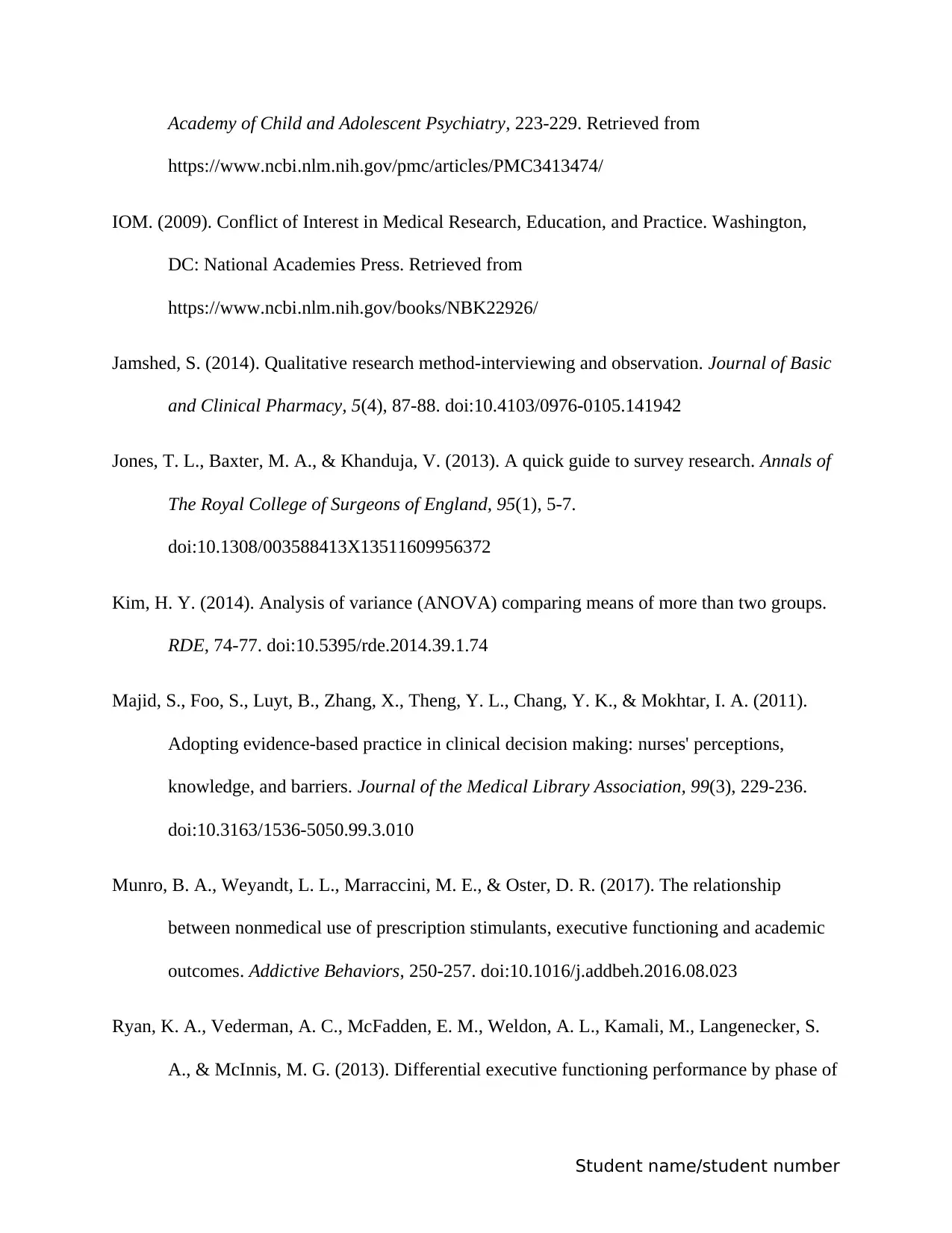
Academy of Child and Adolescent Psychiatry, 223-229. Retrieved from
https://www.ncbi.nlm.nih.gov/pmc/articles/PMC3413474/
IOM. (2009). Conflict of Interest in Medical Research, Education, and Practice. Washington,
DC: National Academies Press. Retrieved from
https://www.ncbi.nlm.nih.gov/books/NBK22926/
Jamshed, S. (2014). Qualitative research method-interviewing and observation. Journal of Basic
and Clinical Pharmacy, 5(4), 87-88. doi:10.4103/0976-0105.141942
Jones, T. L., Baxter, M. A., & Khanduja, V. (2013). A quick guide to survey research. Annals of
The Royal College of Surgeons of England, 95(1), 5-7.
doi:10.1308/003588413X13511609956372
Kim, H. Y. (2014). Analysis of variance (ANOVA) comparing means of more than two groups.
RDE, 74-77. doi:10.5395/rde.2014.39.1.74
Majid, S., Foo, S., Luyt, B., Zhang, X., Theng, Y. L., Chang, Y. K., & Mokhtar, I. A. (2011).
Adopting evidence-based practice in clinical decision making: nurses' perceptions,
knowledge, and barriers. Journal of the Medical Library Association, 99(3), 229-236.
doi:10.3163/1536-5050.99.3.010
Munro, B. A., Weyandt, L. L., Marraccini, M. E., & Oster, D. R. (2017). The relationship
between nonmedical use of prescription stimulants, executive functioning and academic
outcomes. Addictive Behaviors, 250-257. doi:10.1016/j.addbeh.2016.08.023
Ryan, K. A., Vederman, A. C., McFadden, E. M., Weldon, A. L., Kamali, M., Langenecker, S.
A., & McInnis, M. G. (2013). Differential executive functioning performance by phase of
Student name/student number
https://www.ncbi.nlm.nih.gov/pmc/articles/PMC3413474/
IOM. (2009). Conflict of Interest in Medical Research, Education, and Practice. Washington,
DC: National Academies Press. Retrieved from
https://www.ncbi.nlm.nih.gov/books/NBK22926/
Jamshed, S. (2014). Qualitative research method-interviewing and observation. Journal of Basic
and Clinical Pharmacy, 5(4), 87-88. doi:10.4103/0976-0105.141942
Jones, T. L., Baxter, M. A., & Khanduja, V. (2013). A quick guide to survey research. Annals of
The Royal College of Surgeons of England, 95(1), 5-7.
doi:10.1308/003588413X13511609956372
Kim, H. Y. (2014). Analysis of variance (ANOVA) comparing means of more than two groups.
RDE, 74-77. doi:10.5395/rde.2014.39.1.74
Majid, S., Foo, S., Luyt, B., Zhang, X., Theng, Y. L., Chang, Y. K., & Mokhtar, I. A. (2011).
Adopting evidence-based practice in clinical decision making: nurses' perceptions,
knowledge, and barriers. Journal of the Medical Library Association, 99(3), 229-236.
doi:10.3163/1536-5050.99.3.010
Munro, B. A., Weyandt, L. L., Marraccini, M. E., & Oster, D. R. (2017). The relationship
between nonmedical use of prescription stimulants, executive functioning and academic
outcomes. Addictive Behaviors, 250-257. doi:10.1016/j.addbeh.2016.08.023
Ryan, K. A., Vederman, A. C., McFadden, E. M., Weldon, A. L., Kamali, M., Langenecker, S.
A., & McInnis, M. G. (2013). Differential executive functioning performance by phase of
Student name/student number
⊘ This is a preview!⊘
Do you want full access?
Subscribe today to unlock all pages.

Trusted by 1+ million students worldwide
1 out of 13
Related Documents
Your All-in-One AI-Powered Toolkit for Academic Success.
+13062052269
info@desklib.com
Available 24*7 on WhatsApp / Email
![[object Object]](/_next/static/media/star-bottom.7253800d.svg)
Unlock your academic potential
Copyright © 2020–2025 A2Z Services. All Rights Reserved. Developed and managed by ZUCOL.





